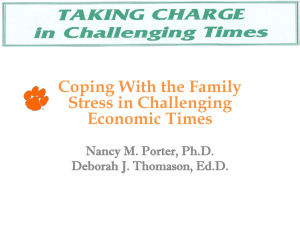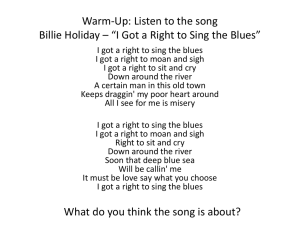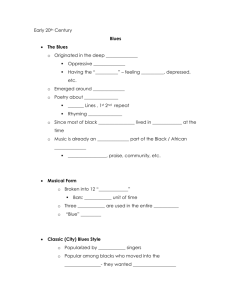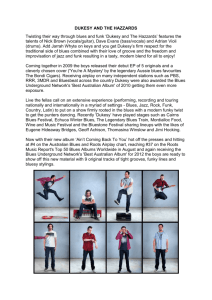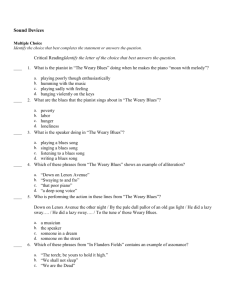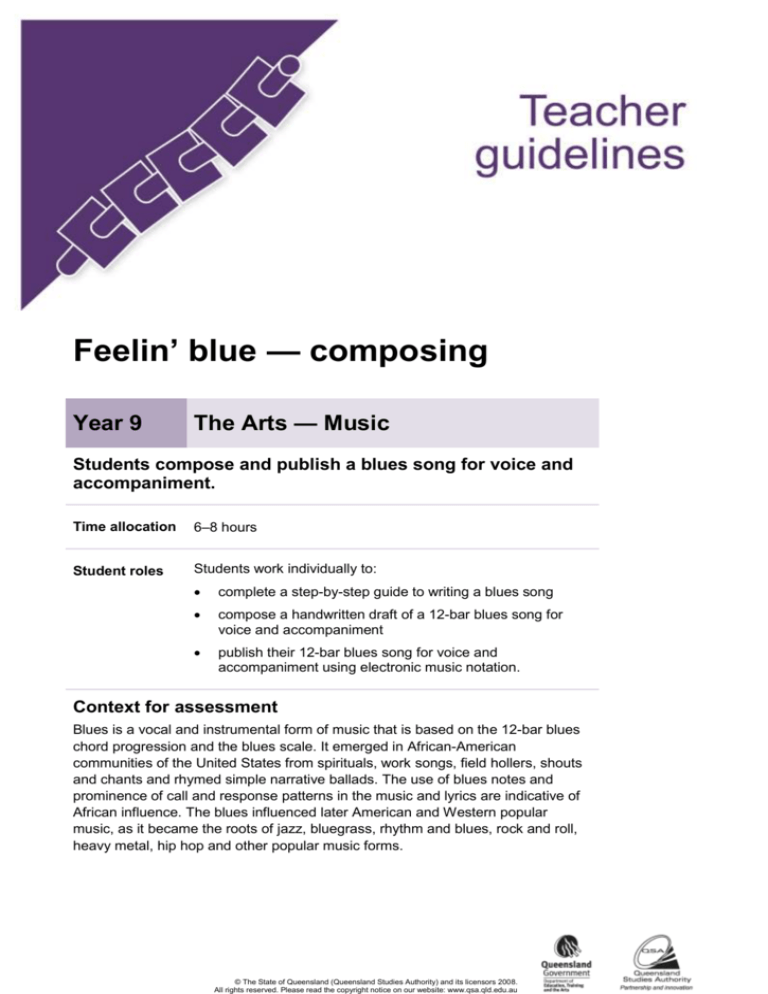
Feelin’ blue — composing
Year 9
The Arts — Music
Students compose and publish a blues song for voice and
accompaniment.
Time allocation
6–8 hours
Student roles
Students work individually to:
complete a step-by-step guide to writing a blues song
compose a handwritten draft of a 12-bar blues song for
voice and accompaniment
publish their 12-bar blues song for voice and
accompaniment using electronic music notation.
Context for assessment
Blues is a vocal and instrumental form of music that is based on the 12-bar blues
chord progression and the blues scale. It emerged in African-American
communities of the United States from spirituals, work songs, field hollers, shouts
and chants and rhymed simple narrative ballads. The use of blues notes and
prominence of call and response patterns in the music and lyrics are indicative of
African influence. The blues influenced later American and Western popular
music, as it became the roots of jazz, bluegrass, rhythm and blues, rock and roll,
heavy metal, hip hop and other popular music forms.
© The State of Queensland (Queensland Studies Authority) and its licensors 2008.
All rights reserved. Please read the copyright notice on our website: www.qsa.qld.edu.au
Teacher guidelines
This assessment gathers evidence of learning for the following Essential Learnings:
The Arts
Essential Learnings by the end of Year 9
Ways of working
Knowledge and understanding
Students are able to:
Music
make decisions about arts
elements, languages and
cultural protocols in relation to
specific style, function, audience
and purpose of arts works
Music involves singing, playing instruments,
listening, moving, improvising and composing by
manipulating the music elements to express ideas,
considering specific audiences and specific
purposes, through sound.
create and shape arts works by
manipulating arts elements to
express meaning in different
contexts
modify and refine genre-specific
arts works, using interpretive
and technical skills
present arts works to particular
audiences for a specific
purpose, style and function,
using genre specific arts
techniques, skills, processes
and cultural protocols
Duration, beat, time values and metre are used to
create and vary rhythm.
Pitch, tonalities, scales and intervals are used to
create and vary the horizontal arrangement of sound.
Tonalities and harmonies are used to organise music
in different vertical arrangements.
Contemporary, traditional and genre-specific musical
forms are used to structure music.
Interaction between the linear and the vertical
arrangement of music is used to create the texture or
density of sound.
Vocal, instrumental, electronic and computergenerated sound sources have characteristic sound
qualities (tone colour) that can be altered through
methods of production and manipulation.
Relative softness and loudness of sounds, and digital
and electronic devices, are used to change dynamic
levels and expression of music.
reflect on learning, apply new
understandings and justify future
applications.
Assessable elements
Knowledge and understanding
Creating
Source: Queensland Studies Authority 2007, The Arts Essential Learnings by the end of Year 9, QSA, Brisbane.
2
Year 9 The Arts — Music: Feelin’ blue — composing
Information and Communication Technologies (ICTs)
Cross-curriculum priority by the end of Year 9
Creating with ICTs
Students experiment with, select and use ICTs to create a range of responses to suit the
purpose and audience. They use ICTs to develop understanding, demonstrate creativity,
thinking, learning, collaboration and communication across key learning areas. They:
express and creatively represent ideas, information and thinking in innovative ways
develop innovative and creative responses, processes and simple systems
reflect on the use of ICTs as creative tools and apply established criteria to evaluate ICT
responses.
Communicating with ICTs
Students experiment with, select and use ICTs across key learning areas to collaborate
and enhance communication in local and global contexts for an identified purpose and
audience. They:
collaborate, exchange ideas, distribute information, present critical opinions, problem solve
and interpret messages
apply suitable presentation and communication conventions and protocols
select and apply a variety of ICTs to exchange and interpret messages and meanings.
Operating ICTs
Students use a range of advanced ICT functions and applications across key learning
areas to inquire, create, collaborate and communicate, and to efficiently manage
information and data. They:
apply efficient operational sequences for the operation of a variety of ICTs
apply formats and conventions when undertaking tasks
access appropriate support when updating or learning new operational skills.
Source: Queensland Studies Authority 2007, ICTs Cross-curriculum priority by the end of Year 9, QSA, Brisbane.
3
Teacher guidelines
Listed here are suggested learning experiences for students before attempting this assessment.
Explore and listen to a variety of blues songs.
Place blues songs in a social and historical context.
Have a working knowledge of major scales and keys.
Have a thorough knowledge and understanding of the primary chords of I, IV and V and
practise writing and identifying them both aurally and visually.
Learn about and practise using chords in “piano style”.
Learn about instrumental fillers.
Improvise instrumental fillers.
Play and perform blues compositions.
Learn about the blues genre.
Analyse the elements that combine to create a blues song (e.g. syncopation, blues scale, blues
progression, phrasing and form).
Practise analysing blues songs.
Develop aural awareness of hearing and understanding the 12-bar blues progression.
Practise vocal and instrumental improvisation using the blues scale.
Learn about and practise using written music notation.
Learn about and practise using traditional score layout.
Learn about and practise text setting.
Learn about and practise writing and performing syncopated rhythms.
Learn about and practise using genre specific language (see Appendix A: Glossary of music
terms).
Learn how to use the music software notation program that is available at your school.
Practise reflecting on creative decisions and modifying choices to create a refined musical
composition.
4
Year 9 The Arts — Music: Feelin’ blue — composing
Teacher resources
The following resources may be useful:
Background information about Bessie Smith and many recordings of Bessie’s songs which typify
the blues genre can be found at: <www.redhotjazz.com/bessie.html>.
Background information about the blues genre and useful worksheets can be found at:
<www.musicatschool.co.uk/year_9/blues_worksheets.htm>.
An excellent resource of the blues genre, including a “Blues classroom” with resources for
teachers: <www.pbs.org/theblues/classroom.html>.
Jazz, a film by Ken Burns could be useful in showing students a blues performance. Available on
DVD from the ABC shop at: <www.abcshop.com.au>.
Preparing
Consider these points before implementing the assessment.
It may be useful for students to complete the Feelin’ blue — analysing assessment located on
the Assessment Bank website, before undertaking this assessment.
Ensure students know how to format their score prior to commencing this assessment (e.g.
voice at the top of each system, bar lines that join the instruments, time signature, key
signature note alignment etc).
Throughout this assessment students are encouraged to continually reflect on and refine their
choices. Appendix B: The Arts – a creative process outlines the creative and iterative process
students will need to engage in.
Implementation
Consider these points when implementing the assessment.
Depending on your student cohort and available resources you may wish students to compose
their song aurally and record the song onto CD for assessment.
Depending upon class size and computer recourses available, you may need to rotate students
through the draft inputting process in Section 3. Publishing. You may wish students to try
playing their drafts while this rotation takes place.
Possible extension activities
Students compose their own lyrics in a blues style.
Students compose two or more verses and demonstrate contrast in the piano accompaniment
and instrumental fillers.
Feelin’ blue — performing, located on the Assessment Bank website, is a useful follow-on
assessment where students perform their blues songs in small groups. If you choose to do this,
encourage students to compose for instruments played by class members or classroom tuned
percussion.
5
Teacher guidelines
Sample implementation plan
This table shows one way that this assessment can be implemented. It is a guide only — you may
choose to use all, part, or none of the table. You may customise the table to suit your students and
their school environment.
Suggested time
Student activity
Teacher role
Section 1. Write a blues song
1 hour
Complete steps 1–5 of Write a blues
song in their Student booklet.
Assist students by providing
verbal (or written) feedback on
their responses.
30–60 minutes
Improvise and experiment with different
combinations of sounds that would be
suitable for a blues melody, instrumental
fillers and bass line.
Supervise student use of
instruments and encourage
experimentation.
Section 2. Handwritten draft
2 hours
Complete a draft of their composition.
Remind students how to format
their score.
Encourage students to refer to
their checklist.
Provide feedback to students
about their draft.
Section 3. Publish your composition
1–2 hours
Input their draft into a software notation
program (e.g. Sibelius).
Assist students in using music
notation software.
Listen to their songs played through the
computer and determine how they can
improve upon their song by referring to
the checklist provided in the Student
booklet.
Listen to student drafts and help
them to articulate how they can
improve their song.
Make changes and print out a final copy
of their song.
Resources for the assessment
Appendix A
Glossary of music terms
Appendix B
The Arts — A creative process
Instruments — Students may need access to school tuned percussion instruments or keyboards.
Music notation software — If your school does not have music notation software such as Sibelius,
Finale NotePad is a free program that works in a simple but effective way. Available online at:
<www.finalemusic.com/notepad>.
6
Year 9 The Arts — Music: Feelin’ blue — composing
During the learning process, you and your students should have developed a shared
understanding of the curriculum expectations identified as part of the planning process.
After students have completed the assessment, identify, gather and interpret the information
provided in student responses. Use only the evidence in student responses to make your judgment
about the quality of the student learning. Refer to the following documents to assist you in making
standards-referenced judgments:
Guide to making judgments
Indicative A response
Sample responses (where available).
Making judgments about this assessment
If you choose to have your students present their composition as a recording rather than a written
score, be careful to assess their crafting of the composition and the manipulation of musical
elements (e.g. structure, instrumentation, dynamics, tempo, texture, tonality, metre, mood,
articulation, melody, pitch, rhythm and harmony). It is the creation of the composition that is being
assessed, not the performance.
For further information, refer to the resource Using a Guide to making judgments,
available in the Resources section of the Assessment Bank website.
Evaluate the information gathered from the assessment to inform teaching and learning strategies.
Involve students in the feedback process. Give students opportunities to ask follow-up questions
and share their learning observations or experiences.
Focus feedback on the student’s personal progress. Emphasise continuous progress relative to
their previous achievement and to the learning expectations — avoid comparing a student with
their classmates.
Giving feedback about this assessment
Have students listen to each others’ compositions and give each other feedback.
Give students feedback about how they can enhance their creative process.
For further information, refer to the resource Using feedback, available in the
Resources section of the Assessment Bank website.
7
Appendix A
Glossary of music terms
Music, like any subject, has its own terminology. The following are key terms that need to be
understood to complete this assessment.
Accompaniment Vocal or instrumental parts that accompany a melody.
Articulation
The manner in which notes are performed, such as
staccato (short) or legato (smoothly).
Beat
Unit of measure of rhythmic time. A steady pulse.
Blues scale
The arrangement of notes in the following order — 1; b3;
4; b5; 5; b7; 1 — in reference to equivalent major scale.
Balance
When playing in an ensemble, instruments listen to each
other to ensure that there is a good balance. That is, all
parts can be heard and the melody is clear.
Chord
Three or more tones sounded simultaneously.
Clef
(bass or treble)
A symbol written at the beginning of a musical staff
indicating which notes are represented by which lines and
spaces.
Composition
Creation of original music by organising sound. Usually
written for others to perform.
Diatonic scale
The notes found within a major or minor scale.
Dynamics
Varying degrees of volume in the performance of music.
Dynamic
markings
The symbols indicating the varying degrees of volume —
pp pianissimo, very soft; p piano, soft; mp mezzo piano,
medium soft; mf mezzo forte, medium loud; f forte, loud;
and ff fortissimo, very loud.
Elements of
music
Melody, harmony, rhythm and form, and the expressive
elements of dynamics, tempo, and timbre (tone colour).
Embellishments Notes added to ornament a melody or rhythmic pattern.
Form
The organisation and structure of a composition and the
interrelationships of musical events within the overall
structure.
Genre
Type or kind of musical work (e.g. opera, jazz, mariachi).
Harmonic
progression
A succession of individual chords or harmonies that form
larger units of phrases, sections or compositions.
Harmony
The simultaneous sounding of two or more tones.
Instrumental
filler
An improvised melodic and rhythmic pattern. In blues
music, an instrumental filler follows as a response to each
phrase that the singer sings.
Improvisation
Spontaneous creation of music.
Appendix A
Glossary of music terms (continued)
Interval
The distance in pitch between two tones.
Lyrics
The words of a song.
Major key
Tonally, a key based on a major scale; a scale that
contains the following step pattern: whole, whole, half,
whole, whole, whole, half; or uses the solfa tones of do, re,
mi, fa, so, la, ti, do.
Melody
An organised sequence of single notes.
Metre
The grouping of beats by which a piece of music is
measured.
Notation
Written music indicating pitch and rhythm for performance.
Ostinato
A rhythmic or melodic accompaniment figure repeated
continuously.
Phrase
A musical idea comparable to a sentence or a clause in
language.
Pitch
The location of a note related to its highness or lowness.
Rhythm
The combinations of long and short, even or uneven
sounds that convey a sense of movement in time.
Scale
The arrangement of notes in a specific order of whole and
half steps.
Score
The organised notation of all of the instrumental and/or
vocal parts of a composition.
Sliding
A technique used in the blues genre that involves sliding
between two notes.
Staff (staves)
The horizontal lines on and between which notes are
written.
Syncopation
The placement of rhythmic accents on weak beats or
weak portions of beats.
Tempo
The pace at which music moves according to the speed
of the underlying beat.
Texture
The character of the different layers of horizontal and
vertical sounds.
Timbre
Tone colour or quality of sound heard.
Tonality (key)
The tonal centre of a composition.
Triad
A three-note chord consisting of root, third and fifth.
12-bar blues
A chord pattern often used in blues music based on the I,
IV and V chords and the blues scale in specific order
within 12 bars.
Adapted from glossary available at <www.cde.ca.gov/be/st/ss/muglossary.asp>.
Appendix B
The Arts — a creative process
Creating is an important aspect of The Arts.
It is essential that students are taught how to create,
rather than just being asked to create.
The creative process is iterative.
Students' creative skills develop over time.

